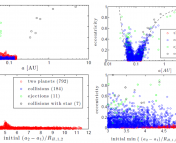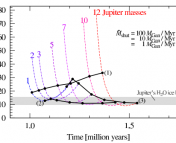Title: Repeated Cyclogenesis on Hot-Exoplanet Atmospheres with Deep Heating
Authors: Jack W. Skinner, Joonas Nättilä, and James Y-K. Cho
First Author’s Institution: California Institute of Technology and Brandeis University
Status: Open access in Physical Review Letters
This bite was written and published as part of Astrobites’s new partnership with the American Physical Society (APS). As part of this partnership, we cover selected articles from the Physical Review Journals, APS’s premier publications covering all aspects of physics. For more coverage as part of this partnership, see our other PRJ posts.
For nearly a decade, NASA’s Juno mission has been returning stunning images of clouds and storms on the planet Jupiter. Missions like Juno have been instrumental to our understanding of the complex atmospheric physics of giant gaseous planets. In contrast to Earth, the deep atmospheres of and immense pressures within Jovian planets allow for three-dimensional circulation on massive scales, which we would never observe here at home. Juno (and other planetary probe missions) allow us to observe the Jovian planets in our own Solar System, but we have no such ability to directly observe exoplanets at this resolution.
Instead, astrophysicists use computational models to predict what might be happening in exoplanet atmospheres. General circulation models (GCMs) are the state-of-the-art for modeling atmospheric physics, stemming from their introduction sixty years ago for modeling Earth’s weather and climate. All the same fluid mechanics apply on Earth, Jupiter, and exoplanets, so the same tools can be applied to different planets with relatively minor modifications. While most exoplanet atmospheric models only consider the upper regions of a planet’s atmosphere, today’s authors use GCMs to simulate hot, tidally locked exoplanets to explore heating and circulation deep in their atmospheres, aiming to understand how these differing scenarios produce new and observable effects.
Seas of Storms
HD 209458 b and WASP-96 b are two well-studied Hot Jupiters that are nearly twins with respect to their sizes, masses, and orbits, making them perfect examples for today’s authors to compare different atmospheric heating scenarios, holding all else equal. Tidally locked planets like HD 209458 b and WASP-96 b are heated by their host stars exclusively on their dayside star-facing hemispheres, creating strong temperature contrasts with their nightsides. Heat flow forces atmospheric circulation across the day-night boundary, causing storms of various sizes, up to planetary-scale cyclones.
According to the authors’ simulations, planets undergoing shallow heating, here represented by HD 209458 b, form modons, pairs of eddies that move against the bulk motion of a fluid like the planet’s atmosphere. These modon pairs, one northern counterclockwise cyclone and one southern clockwise cyclone, move around the surface of the planet and locally mix hot and cool parts of the atmosphere. The GCM simulations found that, despite the atmospheric heating mostly affecting the top regions of the atmosphere, the modons formed tend to persist in the deeper atmosphere, gradually spinning off to the west and sometimes dissipating entirely. While the storm itself is well-mixed, the atmosphere outside the storm isn’t, leaving large hotter and cooler patches, visible as highly-variable thermal flux from the planet.
Figure 1: Top — shallow heating modon pair, slowly drifting westward. Bottom — deep heating cyclones, mixing and churning the atmosphere. Figure 3 in the paper.
In contrast, planets with deep heating, represented by WASP-96 b, form more, smaller storms out of the remnants of a large, but short-lived modon. Rossby waves (like the ones associated with Earth’s polar vortex) break at the borders of the dying modon, forming these smaller cyclones, which then continue to swirl around the planet before themselves dying out. Cycles of storm production and destruction continue, thoroughly mixing the planet’s entire atmosphere and smoothing out the sharp temperature gradients characteristic of tidally locked planets.
Figure 2: Dayside and nightside thermal flux curves for both shallow-heated and deep-heated planets. Shallow-heating produces strong thermal fluctuations while deep-heated planets have more constant temperatures. Figure 4 in the paper.
Hot Air, Bright Clouds
These two different heating scenarios lead to substantially different atmospheric dynamics, meaning they should be able to be observed! By taking the total thermal flux of the simulated planets, the authors predict significant differences would be visible within a few (<10) orbital periods. Shallow-heated planets like HD 209458 b experience large thermal fluctuations — on the order of 10% on short timescales — as their large cyclones drift around their surfaces, moving heat from the dayside to the nightside. Deep-heated planets like WASP-96 b have smaller fluctuations due to their smaller storms, and their hemispheres remain relatively consistently heated, with thermal fluctuations under 5% or so. In total, these account for an observable temperature difference on the order of a hundred Kelvin, which should be easily detectable with current space telescopes like JWST and next-generation space telescopes like Ariel. While these won’t be Juno-level observations, combined with other data like transit and emission spectroscopy (like during a full phase curve), thermal fluxes can give us a more total picture of the complex atmospheric physics on Hot Jupiters.
Featured Image Credit: Skinner et al., Sean Doran/NASA/JPL-Caltech/SwRI/MSSS
Astrobite edited by: Briley Lewis




